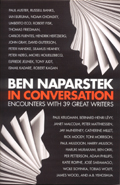In Conversation
Ben Naparstek
Scribe, Melbourne, 2009
SC, 254 pp, $32.95
ISBN: 978-1-921640-11-7
My expectations of this book were set by the title – I was expecting transcripts of interviews with famous writers. By the third ‘conversation’ I was disabused of this notion.
These are forty essays, each about a writer who Naparstek met or had correspondence with. Each piece contains snatches of quotes from the interviews, mixed with comments by Naparstek from a reviewer’s perspective of the writer’s work and quotes from others about the writer and what s/he has produced. The form works well, especially with writers I knew little or nothing about.
The essays make mention of most of each person’s published output. Often they contain the creator’s comments on a particular piece and where it fits into their life and total oeuvre. There are some insights offered into how some of them came to their passion, how they view some of their work (especially early ‘attempts’) and why they keep writing. To me this aspect of the collection is the most interesting. Why do people write? Do they do other things? How do they take reviews and criticisms?
With almost every piece in this book I was left wanting to know more and wishing Naparstek had made them longer. Presumably he has more material to draw on. Another wish is for a good index, which would make the book more accessible for future reference.
Many of the essays will be useful for new and emerging writers looking for ‘advice’. For instance, Seamus Heaney on poetry (p.31):
“By the time you start to compose, more than half the work has been done. The crucial part of the business is what happens before you face the empty page …”
The book is divided into fiction and non-fiction writers, although this is partly an artificial categorisation: many writers have produced in both areas and in between and it is a distinction I do not understand. For instance, Umberto Eco has produced much memorable fiction (e.g. his first novel, The Name of the Rose), yet he appears in the non-fiction category. The division between fiction and non-fiction is not a distinct, straight line; there is also creative non-fiction, which has a foot in both camps, and there is journalism.
In order to absorb enough to be able to write about it, I read the entire book in the space of a few weeks. This has made it more difficult for me to fully appreciate each essay. It is probably better to dip in and out of it, skip some, go back from time to time to gain a different slant or for new inspiration. In Conversation will live in the small collection on the desk where I work.
Putting aside any gripes I have with the book, I need to say that Naparstek is a good writer. I hope he produces more, although his current post as editor of The Monthly may not leave him much time. From the perspective of my seventh decade, I feel some envy of Naparstek in the first half of his third, with already eight years of writing under his belt.
In his Preface, Naparstek does talk of the limitations of the form he has chosen:
“… recognising that whatever I wrote would be a deeply subjective telling – like all profiles, an account of a life and its relationship to a body of writing, synthesised from one or two hours of conversation into just 1500 – 2000 words.”
Each essay is essentially a window into aspects of the writer’s life, thoughts, prejudices and ambitions. Some of them had me taking notes on books to read and some of them had me looking elsewhere for more material on the writer. The interviews are more than mere reporting, as Naparstek’s own thoughts, impressions and reactions come through, as do some of his prejudices. This brings an honesty to the book. Because of its content and structure, this book should offer inspiration, reflection and information to any reader over an extended period. I recommend you get yourself a copy.
[First appeared in The Australian Writer, December 2009]
© 2009 Daan Spijer
[to receive an email each time a new review is posted, email me: <daan dot spijer at gmail dot com>]
 CLICK HERE to download a formatted PDF of the above post
CLICK HERE to download a formatted PDF of the above post
 See more of Daan Spijer’s writing and his photos at Seventh House Communications
See more of Daan Spijer’s writing and his photos at Seventh House Communications

Your review has inspired me to get this book. As an aspiring writer I find it very useful to read any thoughts or advice from established writers. These sources of reference are invaluable for encouragement and inspiration. Thanks for the tip off!